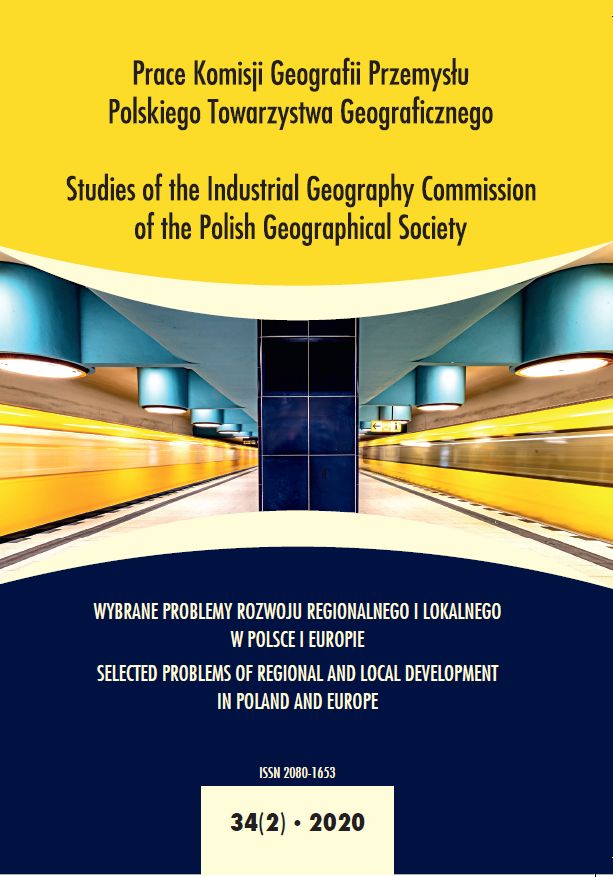Spatial Directions of the Transformation of Retail System in Wrocław
DOI:
https://doi.org/10.24917/20801653.342.5Keywords:
retail, retail structure, shopping malls, system hierarchy, WrocławAbstract
The article presents research verifying the transformation process of the retail structure in Wrocław. It is an interesting example of urban units which experienced the political and economic conditions of two different systems - socialist and capitalist, and also the period of changes in between. Following Palomäki and Zipser’s methodology, the analysis of retail hierarchy changes in Wrocław was carried for three time periods (1979, 1997, 2014). The hierarchy rate was based on 3-dimention data matrix: qualitative, quantitative and spatial. The important part of the research is the graphic visualisation of retail localisation changes. The methods used allow for determining the stable components of the retail system and tendencies of transformation. The results of the research point to important questions. First of all, the stable elements of the hierarchical retail system (stronger than political and economic changes) were observed in the town structure. The centre of the town was recognised as a stable main point of the structure. Secondly, this high position of the centre can be powered by big -box stores. Finally, the components of the system make it a multi -level one, with the number of levels in the hierarchy being changeable.
Downloads
Metrics
References
Christaller, W. (1966). Central Places in Southern Germany. Englewood Cliffs: Prentice-Hall.
Kajdanek, K. (2006). Nowe przestrzenie centrum? O znaczeniu galerii handlowych w obrazie przestrzenno‑funkcjonalnym centrum miasta Wrocławia. XIX Konserwatorium Wiedzy o Mieście. Łódź, 255–264.
Kuc‑Słuszniak, B. (2008). Sundries fair – vanity fair. Czasopismo Techniczne, 3-A, 135–141.
Ledwoń, S. (2008). Wpływ współczesnych obiektów handlowych na strukturę śródmieść. Gdańsk: Politechnika Gdańska.
Maleszyk, E. (1998). Zagraniczne sieci handlowe w Polsce. Wiadomości Statystyczne, 8.
Mayer‑Wydra, M. (2018). W kierunku normalizacji wyników badań o handlu detalicznym. Próba reklasyfikacji działalności handlowej. Prace Komisji Geografii Przemysłu Polskiego Towarzystwa Geograficznego, 32(2), 255–277.
Mayer‑Wydra, M. (2019). Wzorce struktury hierarchicznej miejskich układów handlowych na tle transformacji ustrojowej. Badania na przykładzie wybranych miast polskich. Wrocław: Politechnika Wrocławska.
Namyślak, B. (2006). Rozwój wielkopowierzchniowych obiektów handlowych we Wrocławiu. W: I. Jażdżewska (red.). Nowe przestrzenie w miastach. Ich organizacja i funkcjonowanie. Łódź: Wyd. Uniwersytetu Łódzkiego, 265–276.
Őner, Ő., Larsson, J.P. (2014). Location and co‑location in retail: a probabilistic approach using geo‑coded data for metropolitan retail markets. The Annals of Regional Science, 52(2), 385–408.
Palomäki, M. (1964). The functional centers and areas of South Bothnia, Finland. Feni. 7 W realnym odzwierciedleniu tych dystansów powinniśmy mówić raczej o izochronach aniżeli o orbitach ze względu na ich nieregularny kształt.
Pavils, M., Singleton, A. (2018). Retail Areas and their Catchments. W: P. Longley, J. Cheshire, A. Singleton. The Consumer Data Research. London: UCL Press.
Pluta, J., Damurski, Ł., Ładysz, J., Zipser, W., Mayer‑Wydra, M. (2018). The Structure of Users’ Needs in Local Service Centres in Urban and Suburban Settlements. Comparative Study of I.L. Pereca Square in Wrocław and Siechnice Main Square (Poland). Studies of the Industrial Geography Commission of the Polish Geographical Society, 32(2), 229–244.
Pustelnik, R. (1979). Rozmieszczenie miejskich usług handlowych i ich struktura hierarchiczna na przykładzie czterech miast polskich. Wrocław: Politechnika Wrocławska.
Studium uwarunkowań i kierunków zagospodarowania przestrzennego Wrocławia (2018).Pozyskano z http://bip.um.wroc.pl/artykuly/195/studium-uwarunkowan-i-kierunkow-zagospodarowania-przestrzennego-wroclawia
Studium uwarunkowań i kierunków zagospodarowania przestrzennego Warszawy (2010). Pozyskano z http://architektura.um.warszawa.pl/studium
Zallam, I. (1993). Analiza struktury hierarchii zagospodarowania turystycznego i usługowego w obszarach o rozwiniętej funkcji rekreacyjnej. Wrocław: Politechnika Wrocławska.
Zipser, T. (red.) (1977). Wstępne określenie zasad struktury przestrzennej sieci obiektów usługowych. Wrocław: Instytut Architektury i Urbanistyki, Politechnika Wrocławska.
Zipser, T., Mlek, M. (2005). Modelowe próby interpretacji prawa Zipfa w systemie osadniczym. Studia Komitetu Przestrzennego Zagospodarowania Kraju Polskiej Akademii Nauk, CXIV. Warszawa: Wyd. Naukowe PWN.
Zipser, T., Sławski, J. (1988). Modele procesów urbanizacji. Teoria i jej wykorzystanie w praktyce planowania. Warszawa: Polskie Wydawnictwo Ekonomiczne.
Zipser, W. (2010). Metody prognozowania struktur handlowo‑usługowych w metropoliach na podstawie modelu podróży o celu usługowym. Czasopismo Techniczne, 107(3), 1-A.
Downloads
Published
How to Cite
Issue
Section
License
Articles are published under the terms of the Creative Commons License (CC BY-ND 4.0; Attribution– NoDerivs).

